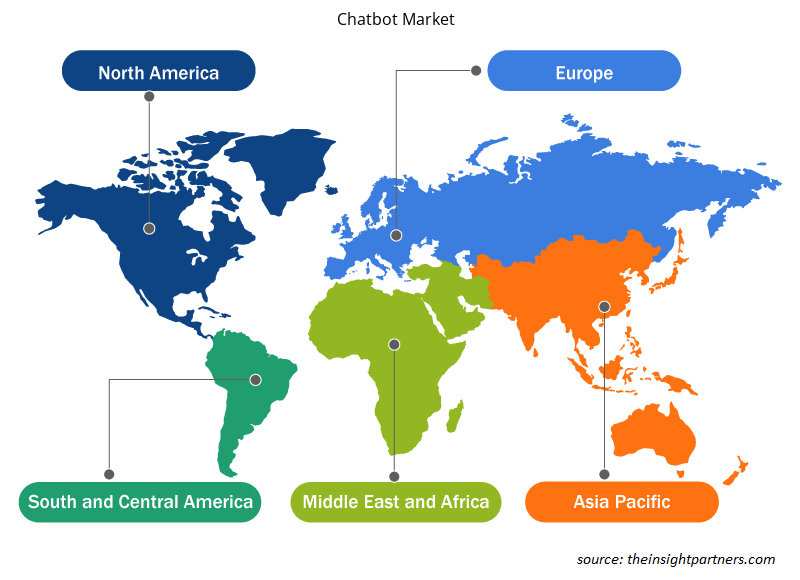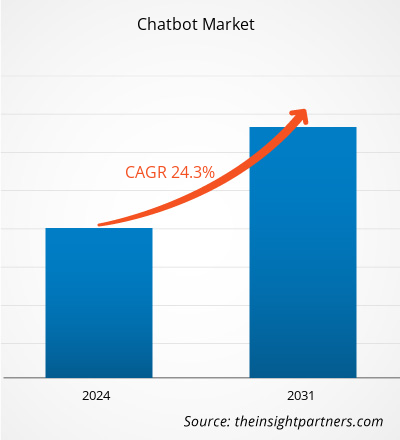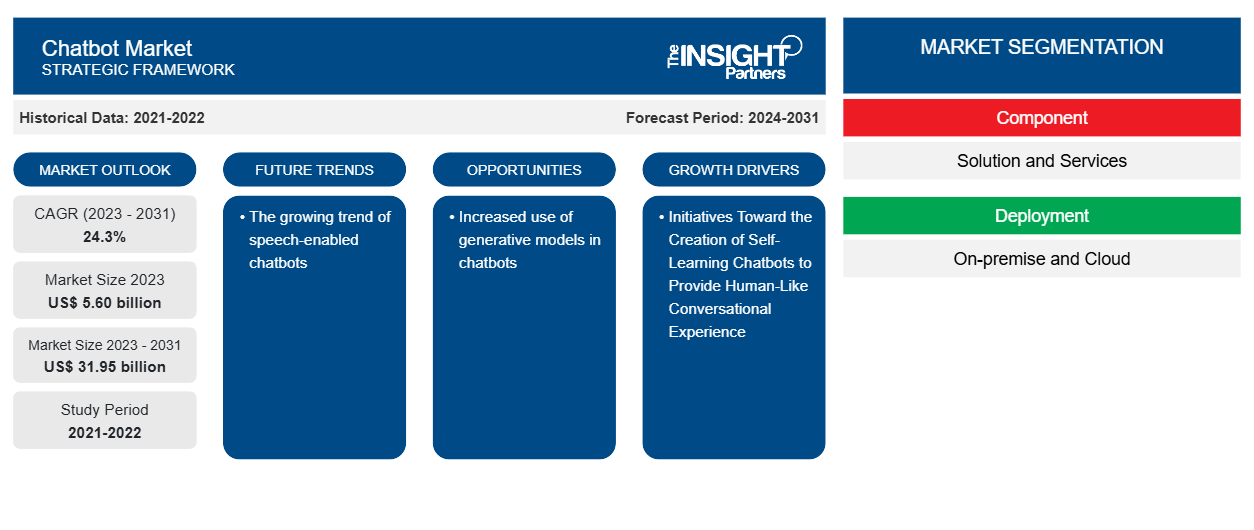Si prevede che la dimensione del mercato dei chatbot raggiungerà i 31,95 miliardi di dollari entro il 2031, rispetto ai 5,60 miliardi di dollari del 2023. Si prevede che il mercato dei chatbot registrerà un CAGR del 24,3% nel 2023-2031. Il mercato è guidato principalmente dalla crescente predominanza delle applicazioni di messaggistica e dalla crescente domanda di analisi dei clienti.
Analisi di mercato dei chatbot
I modelli generativi possono migliorare le capacità di elaborazione del linguaggio naturale (NLP) dei chatbot, portando a una migliore comprensione e risposta al linguaggio umano. I modelli generativi, come GPT-4, possono migliorare la comprensione dei chatbot delle preferenze e delle abitudini degli utenti, consentendo raccomandazioni e supporto più personalizzati. A causa della crescente popolarità delle applicazioni di messaggistica, l'integrazione dei chatbot con i messenger produce un ritorno sull'investimento più elevato perché rivolgersi ai clienti tramite la loro applicazione preferita migliora l'esperienza utente.
Panoramica del mercato dei chatbot
Il mercato dei chatbot è cresciuto notevolmente negli ultimi anni. La necessità di fornire un servizio clienti 24 ore su 24, 7 giorni su 7 e di ridurre i costi operativi delegando i compiti ai chatbot, nonché l'aumento del desiderio dei clienti per le operazioni self-service, hanno contribuito ad aumentare la domanda. Ciò può essere collegato alla crescente preferenza degli individui per le applicazioni di messaggistica rispetto ai siti di social network. Si prevede che i chatbot progettati per l'integrazione con le app di messaggistica vedranno un'elevata domanda di mercato in futuro. Inoltre, i chatbot stanno crescendo in popolarità poiché le organizzazioni si sforzano di automatizzare le loro vendite e l'assistenza clienti. L'uso dei chatbot consente alle aziende di fornire servizi tempestivi a costi inferiori.
Personalizza questo report in base alle tue esigenze
Riceverai la personalizzazione gratuita di qualsiasi report, comprese parti di questo report, o analisi a livello nazionale, pacchetto dati Excel, oltre a usufruire di grandi offerte e sconti per start-up e università
-
Scopri le principali tendenze di mercato in questo rapporto.Questo campione GRATUITO includerà analisi di dati che spaziano dalle tendenze di mercato alle stime e alle previsioni.
Driver e opportunità del mercato dei chatbot
Maggiore utilizzo di modelli generativi nei chatbot per favorire il mercato
L'intelligenza artificiale ha visto notevoli sviluppi di recente, in particolare per quanto riguarda l'intelligenza artificiale generativa e gli LLM. I modelli basati sul deep learning generano nuovi contenuti identificando pattern in vasti set di dati. Il chatbot di OpenAl, ChatGPT, utilizza il modello linguistico GPT-3.5 per generare una prosa simile a quella umana che riconosce il contesto. Oltre al testo in testo, l'intelligenza artificiale generativa può anche convertire immagini, video , modelli 3D, musica e altro. L'intelligenza artificiale generativa consente alle aziende di generare idee uniche per prodotti, servizi e soluzioni in modo più rapido ed efficiente. L'intelligenza artificiale generativa fornisce alle organizzazioni conoscenze basate sui dati per un processo decisionale informato e riduce le spese connesse allo sviluppo del prodotto e ai cicli di marketing.
Iniziative per la creazione di chatbot auto-apprendenti per fornire un'esperienza conversazionale simile a quella umana
I chatbot possono adattarsi ad ambienti mutevoli e imparare dalle loro azioni, esperienze e conclusioni. I chatbot analizzano i dati rapidamente e forniscono supporto in molte lingue, rendendo più facile per i clienti trovare le informazioni di cui hanno bisogno. I bot autoapprendenti utilizzano il comportamento basato sui dati, la tecnologia NLP e l'apprendimento automatico supervisionato per fornire una comunicazione più naturale. Possono imparare dai loro errori. Sono in corso diversi sforzi per la creazione di chatbot autoapprendenti. I chatbot autoapprendenti offrono risposte personalizzate e appropriate, migliorando l'esperienza del consumatore. Il chatbot continua a imparare dalle interazioni dell'utente.
Analisi della segmentazione del rapporto di mercato dei chatbot
I segmenti chiave che hanno contribuito alla derivazione dell'analisi di mercato dei chatbot sono i componenti, l'implementazione, la dimensione dell'organizzazione di utilizzo e l'utente finale.
- In base ai componenti, il mercato dei chatbot è segmentato in soluzioni e servizi.
- In base all'implementazione, il mercato dei chatbot è segmentato in on-premise e cloud.
- In base all'utilizzo, il mercato dei chatbot è segmentato in siti web, contact center, social media e piattaforme mobili.
- In base all'utente finale, il mercato dei chatbot è segmentato in istruzione, commercio al dettaglio ed e-commerce, BFSI, assistenza sanitaria, viaggi e turismo e altri.
Analisi della quota di mercato dei chatbot per area geografica
L'ambito geografico del report di mercato sui chatbot è suddiviso principalmente in cinque regioni: Nord America, Asia Pacifico, Europa, Medio Oriente e Africa e Sud America/Sud e Centro America. L'Asia-Pacifico sta assistendo a un'enorme industrializzazione, che aumenta la domanda di chatbot sul mercato. La crescita dei settori della vendita al dettaglio e dell'e-commerce in nazioni emergenti come Cina, India, Indonesia, Vietnam, Malesia, Filippine e Thailandia ha accelerato l'elevata domanda e l'ampia accettazione dei chatbot tra commercianti e proprietari di aziende di e-commerce .
Approfondimenti regionali sul mercato dei chatbot
Le tendenze regionali e i fattori che influenzano il mercato dei chatbot durante il periodo di previsione sono stati ampiamente spiegati dagli analisti di Insight Partners. Questa sezione discute anche i segmenti e la geografia del mercato dei chatbot in Nord America, Europa, Asia Pacifico, Medio Oriente e Africa e Sud e Centro America.

- Ottieni i dati specifici regionali per il mercato dei chatbot
Ambito del rapporto di mercato sui chatbot
| Attributo del report | Dettagli |
|---|---|
| Dimensioni del mercato nel 2023 | 5,60 miliardi di dollari USA |
| Dimensioni del mercato entro il 2031 | 31,95 miliardi di dollari USA |
| CAGR globale (2023-2031) | 24,3% |
| Dati storici | 2021-2022 |
| Periodo di previsione | 2024-2031 |
| Segmenti coperti |
Per componente
|
| Regioni e Paesi coperti |
America del Nord
|
| Leader di mercato e profili aziendali chiave |
|
Densità dei player del mercato dei chatbot: comprendere il suo impatto sulle dinamiche aziendali
Il mercato del Chatbot Market sta crescendo rapidamente, spinto dalla crescente domanda degli utenti finali dovuta a fattori quali l'evoluzione delle preferenze dei consumatori, i progressi tecnologici e una maggiore consapevolezza dei vantaggi del prodotto. Con l'aumento della domanda, le aziende stanno ampliando le loro offerte, innovando per soddisfare le esigenze dei consumatori e capitalizzando sulle tendenze emergenti, il che alimenta ulteriormente la crescita del mercato.
La densità degli operatori di mercato si riferisce alla distribuzione di aziende o società che operano in un particolare mercato o settore. Indica quanti concorrenti (operatori di mercato) sono presenti in un dato spazio di mercato in relazione alle sue dimensioni o al valore di mercato totale.
Le principali aziende che operano nel mercato dei chatbot sono:
- Servizi Web Amazon
- Soluzioni artificiali
- Società Creative Virtual Pvt. Ltd.
- Azienda CX
- Società eGain
- Società IBM
Disclaimer : le aziende elencate sopra non sono classificate secondo un ordine particolare.

- Ottieni una panoramica dei principali attori del mercato dei chatbot
Notizie e sviluppi recenti del mercato dei chatbot
Il mercato dei chatbot viene valutato raccogliendo dati qualitativi e quantitativi dopo la ricerca primaria e secondaria, che include importanti pubblicazioni aziendali, dati associativi e database. Di seguito è riportato un elenco degli sviluppi nel mercato:
- Ad aprile 2023, - Zendesk ha stretto una partnership con OpenAI, un importante laboratorio di ricerca sull'intelligenza artificiale con sede negli Stati Uniti. L'azienda avrebbe fornito ai propri utenti soluzioni supportate dall'intelligenza artificiale per semplificare le attività di generazione dei ticket per i dipendenti del CX e del servizio clienti. Zendesk e OpenAI stanno lavorando insieme per migliorare le capacità dei modelli di base di Zendesk, che sono proprietari, integrandoli con quelli di OpenAI.
(Fonte: Zendesk, Comunicato stampa, 2021)
- A gennaio 2023, Kore.ai ha annunciato che presenterà RetailAssist, una soluzione di assistenza alle vendite conversazionale per il settore della vendita al dettaglio, alla fiera National Federation of Retailers (NRF 2023) di New York City.
(Fonte: Kore.ai, Comunicato stampa, 2023)
Copertura e risultati del rapporto sul mercato dei chatbot
Il rapporto "Dimensioni e previsioni del mercato dei chatbot (2021-2031)" fornisce un'analisi dettagliata del mercato che copre le seguenti aree:
- Dimensioni e previsioni del mercato a livello globale, regionale e nazionale per tutti i segmenti di mercato chiave coperti dall'ambito
- Dinamiche di mercato come fattori trainanti, vincoli e opportunità chiave
- Principali tendenze future
- Analisi dettagliata delle cinque forze PEST/Porter e SWOT
- Analisi di mercato globale e regionale che copre le principali tendenze di mercato, i principali attori, le normative e gli sviluppi recenti del mercato
- Analisi del panorama industriale e della concorrenza che copre la concentrazione del mercato, l'analisi della mappa di calore, i principali attori e gli sviluppi recenti
- Profili aziendali dettagliati
- Analisi storica (2 anni), anno base, previsione (7 anni) con CAGR
- Analisi PEST e SWOT
- Valore/volume delle dimensioni del mercato - Globale, Regionale, Nazionale
- Industria e panorama competitivo
- Set di dati Excel
Report recenti
Testimonianze
Motivo dell'acquisto
- Processo decisionale informato
- Comprensione delle dinamiche di mercato
- Analisi competitiva
- Analisi dei clienti
- Previsioni di mercato
- Mitigazione del rischio
- Pianificazione strategica
- Giustificazione degli investimenti
- Identificazione dei mercati emergenti
- Miglioramento delle strategie di marketing
- Aumento dell'efficienza operativa
- Allineamento alle tendenze normative























 Ottieni un campione gratuito per - Mercato dei chatbot
Ottieni un campione gratuito per - Mercato dei chatbot